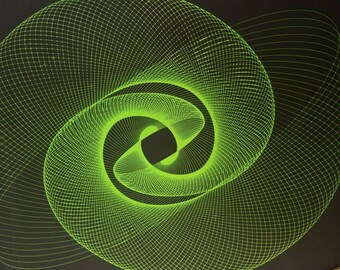
"And they were looking at me with their mouths open like, 'Wow.'" "I stood in front of the board of directors and said, 'This is the new product.' It was a pack of five or six, and took the color out and started coloring it and said, 'This is how I would do it, but this is how a 4-year-old would do it,' and I started going completely across the poster with the marker, and the only thing you saw was where it was white," he says. He made two prototypes and pitched the idea at a board meeting. And instead of paper, he overlaid the poster with black flock, which gives it a velvet feel. Instead of filling in color, he'd leave the image white. A few months after Choquette started, he came up with the idea for a new take on the blacklight poster. He didn't get it, so he walked around town with his portfolio and wandered into Western Graphics, where he was hired.Īt the time, the company had about 20 blacklight posters, but was focused mainly on doing silk-screen printing on glass. He first visited Eugene in 1979 for a job interview at a radio station. This makes sense Choquette came from counterculture, but worked in advertising most of his life, following in the footsteps of other hippie artists who eventually cashed in.Ĭhoquette worked as an artist in the '60s and '70s in San Francisco, where he rubbed elbows with counterculture icons like Bill Graham. The blacklight fuzzy poster was both a return to the creativity of the 1960s and a commodification of the time. Fuzzy blacklight posters were for the '80s stoner hippies who missed the '60s but loved the Grateful Dead "Touch of Grey" era, probably smoked with Zane Kesey and brushed their teeth exclusively with Tom's of Maine. The posters eventually came to define the aesthetic of the '60s, as synonymous with stoner culture as lava lamps and LSD. We are in the business of bringing people together over a beer.Blacklight posters originally gained popularity in the 1960s as a "way of getting high with yourself," according to Dan Donahue in Ultraviolet: 69 Classic Blacklight Posters From the Aquarian Age and Beyond. In an April 14 statement, Anheuser-Busch CEO Brendan Whitworth said the company "never intended to be part of a discussion that divides people.

"For a company to hire a trans person and then not publicly stand by them is worse, in my opinion, than not hiring a trans person at all - because it gives customers permission to be as transphobic and hateful as they want," Mulvaney said, without naming Bud Light.īelgium-based ABInBev didn't immediately respond to emails seeking comment Friday. In the weeks and months that followed, two marketing executives at parent company Anheuser-Busch InBev took a leave of absence, Bud Light lost its decades-long position as America's best-selling beer and the Human Rights Campaign, the country's largest advocacy group for LGBTQ rights, suspended its benchmark equality and inclusion rating for the brewing giant. She showed off a can emblazoned with her face that Bud Light sent to her - one of many corporate freebies she gets and shares with her millions of followers.Ĭonservative figures and others called for a boycott of Bud Light, while Mulvaney's supporters criticized the brand for not doing enough to support her.ĭuration 2:17 Bud Light’s hiring of trans influencer Dylan Mulvaney prompted conservative backlash, but the company’s handling of that backlash lead to even more criticism from the LGBT community.

Black light poster black felt cracked#
I've been followed, and I have felt a loneliness that I wouldn't wish on anyone."Ī deluge of criticism and hate erupted soon after Mulvaney cracked open a Bud Light in an Instagram video on April 1 as part of a social media promotion for the beer.

"For months now, I've been scared to leave my house," Mulvaney said.

But they never did." She said she should have spoken out sooner but was afraid and hoped things would get better - but they didn't. In a video posted Thursday to Instagram and TikTok, she said she "was waiting for the brand to reach out to me. Transgender influencer Dylan Mulvaney says she felt abandoned by Bud Light after facing "more bullying and transphobia than I could have ever imagined" over her partnership with the beer giant.


 0 kommentar(er)
0 kommentar(er)
